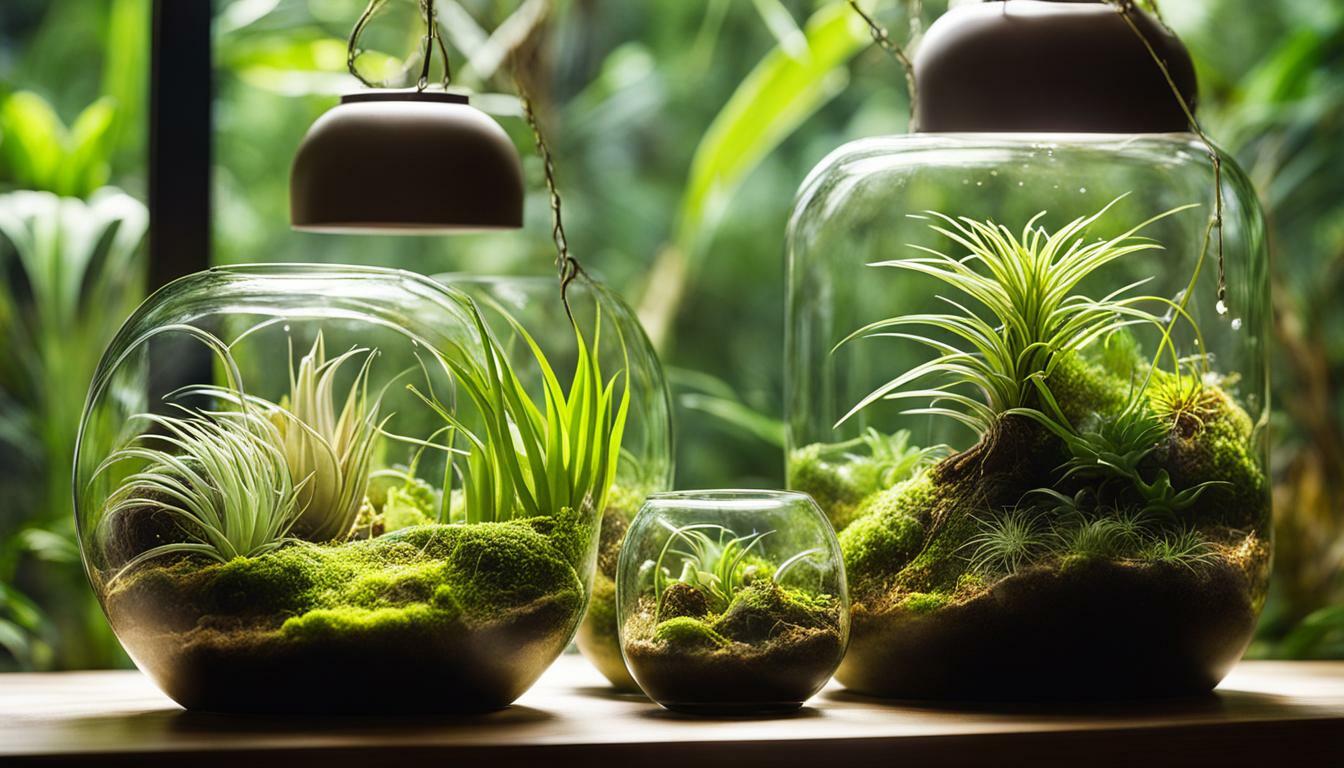This guide provides valuable information on selecting and caring for terrarium plants and air plants. Whether you’re a beginner or an experienced gardener, this guide will help you create a thriving green oasis in your home or office.
2. Terrarium plants and air plants are the perfect addition to any space. They not only add a touch of beauty and freshness but also offer numerous benefits. Terrarium plants are specifically chosen for their ability to thrive in the unique environment of a terrarium, while air plants are known for their minimal rooting requirements and stunning aerial displays.
- Choosing the right terrarium plants is crucial for their long-term health and vitality.
- Air plants are unique in their ability to grow and thrive without soil, making them an excellent choice for terrariums.
- Consider the specific care requirements of each plant species when creating your terrarium.
- Research reputable online sources to find a wide variety of terrarium plants for sale.
- Experiment with different plant combinations and arrangements to create a visually stunning terrarium.
With the right knowledge and care, you can create a beautiful and thriving terrarium filled with lush greenery and unique air plants. Whether you’re new to the world of terrarium gardening or a seasoned expert, this guide will provide you with the essential information to make your terrarium a stunning centerpiece in any space.
Types of Terrarium Plants for Air plants
When it comes to choosing the best terrarium plants for air plants, there are several options to consider. Whether you have a closed terrarium or an open one, selecting the right plants is essential for their survival and thriving. Let’s explore some of the top choices for terrarium plants that are compatible with air plants, along with their care and maintenance requirements.
Hanging Terrarium with Air Plants
One popular choice for an open terrarium is to create a hanging display with air plants. These unique plants require minimal care and can be easily suspended from the ceiling or mounted on a wall. They add a touch of modern elegance to any space and can be complemented with other hanging plants to create a stunning visual effect.
Some recommended terrarium plants for air plants that work well in a hanging display include:
| Plant | Light Requirements | Watering Frequency |
|---|---|---|
| Tillandsia ionantha | Medium to bright indirect light | Soak once a week |
| Tillandsia xerographica | Bright indirect light | Mist every few days |
| Tillandsia aeranthos | Filtered or indirect light | Soak once a week |
Source: SEO-Writing
Closed Terrarium with Tropical Plants
If you prefer a closed terrarium, tropical plants are an excellent choice. These plants thrive in high humidity environments with limited airflow, making them perfect for closed terrariums. They create a lush and vibrant miniature ecosystem that requires minimal maintenance.
Some top choices for terrarium plants for air plants in a closed terrarium include:
- Nerve Plant (Fittonia)
- Selaginella
- Peperomia
These plants not only enhance the visual appeal of the terrarium but also help to maintain the moisture levels within the container. They require moderate indirect light and regular misting to keep the humidity at the right level.
In conclusion, choosing the right terrarium plants for air plants is crucial for their overall health and growth. Whether you opt for a hanging display with air plants or a closed terrarium with tropical plants, make sure to provide the appropriate light and water requirements. With proper care and maintenance, your terrarium will become a beautiful and thriving green oasis.
Finding Terrarium Plants for Sale Online
When it comes to finding terrarium plants for sale online, beginners may feel overwhelmed by the wide range of options available. However, with some guidance and a little research, you can easily find the perfect plants to enhance your terrarium.
One of the best ways to start your search is by visiting reputable websites that specialize in terrarium plants. These websites offer a variety of plant options, from air plants to small and miniature plants suitable for closed terrariums. They often provide detailed descriptions of each plant, including care instructions and maintenance requirements. This can be especially helpful for beginners who are new to terrarium gardening and need guidance on choosing the right plants.
Another option is to explore online marketplaces where individuals sell terrarium plants. These marketplaces allow you to browse through a wide selection of plants from different sellers, offering a variety of sizes, colors, and species. It’s important to do some research on the sellers to ensure they have positive reviews and a good reputation. This way, you can have confidence in purchasing healthy and well-cared-for plants for your terrarium.
| Website | Description | User Reviews |
|---|---|---|
| TerrariumsRUs.com | A wide selection of terrarium plants, specializing in air plants and small varieties. | 4.5 stars |
| TerraPlants.com | Offers a variety of terrarium plants, including closed terrarium options and rare species. | 4.7 stars |
| TerraMarketplace.com | A platform for individuals to sell their terrarium plants, with a range of options to choose from. | 4.3 stars |
Remember, when selecting terrarium plants online, consider the overall decor and style of your terrarium. Look for plants that complement the theme and colors of your terrarium to create a visually appealing and cohesive display. With a little research and patience, you’ll find the perfect terrarium plants for beginners that will add beauty and life to your indoor garden.
Choosing Terrarium Plants for Air Plants Decoration
When it comes to using terrarium plants for air plant decoration, there are a few key factors to consider. First and foremost, you’ll want to choose plants that can thrive in the same environmental conditions as air plants. This means selecting plants that are comfortable in higher humidity levels and can withstand the occasional misting or soaking that air plants require.
One popular choice for air plant decoration is the Tillandsia family, which includes a wide variety of unique and eye-catching plants. These plants are known for their ability to grow without soil and make excellent companions for air plants in a terrarium. The Spanish Moss (Tillandsia usneoides) is a particularly popular choice, with its delicate and flowing appearance adding a touch of elegance to any terrarium.
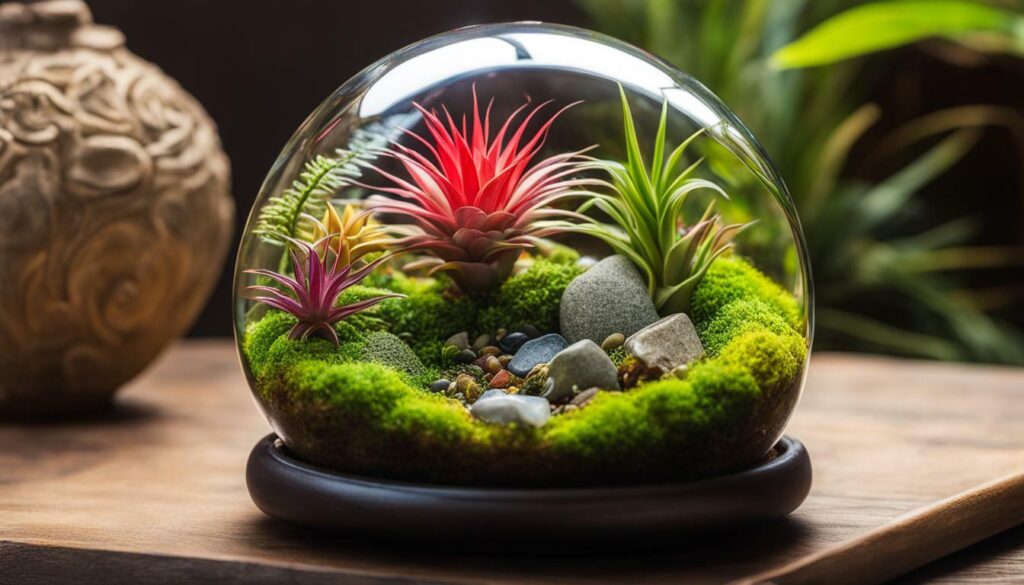
In addition to Tillandsia, other suitable options for air plant decoration include small ferns, mosses, and miniature orchids. These plants not only provide a visually appealing backdrop for your air plants but also help create a natural and lush environment within the terrarium.
With the right terrarium plants for air plant decoration, you can transform your terrarium into a stunning and vibrant display that highlights the beauty of both the plants and the air plants. Experiment with different plant combinations and arrangements to create a personalized and visually striking terrarium.
Small and Miniature Plants for Closed Terrariums
Creating a closed terrarium can be a fun and rewarding project. These self-contained ecosystems require minimal maintenance and can bring a touch of nature to any space. When choosing plants for a closed terrarium, it’s important to select ones that will thrive in the enclosed environment. Small and miniature plants are particularly suitable for closed terrariums because they won’t outgrow the limited space. Here are some top recommendations:
- Selaginella: Also known as the resurrection plant, Selaginella is a great option for closed terrariums. Its small size and lush green foliage add a vibrant touch to the terrarium. Selaginella thrives in high humidity and low light conditions, making it a perfect fit for closed terrariums.
- Fittonia: Commonly known as the nerve plant, Fittonia is another excellent choice. With its striking veined leaves in various shades of green, pink, or white, it adds visual interest to the terrarium. Fittonia prefers medium to bright indirect light and thrives in the humid environment of a closed terrarium.
- Miniature ferns: Ferns are classic choices for closed terrariums due to their love for humidity. There are many miniature fern varieties available, such as the button fern or maidenhair fern, that will fit perfectly in a closed terrarium. These ferns add a touch of elegance and grace to the enclosed space.
These small and miniature plants complement each other beautifully and create a lush and enchanting miniature world inside the closed terrarium. Remember to provide adequate air circulation by occasionally opening the lid of the terrarium to prevent excessive moisture buildup. This will help maintain a healthy environment for the plants to thrive.
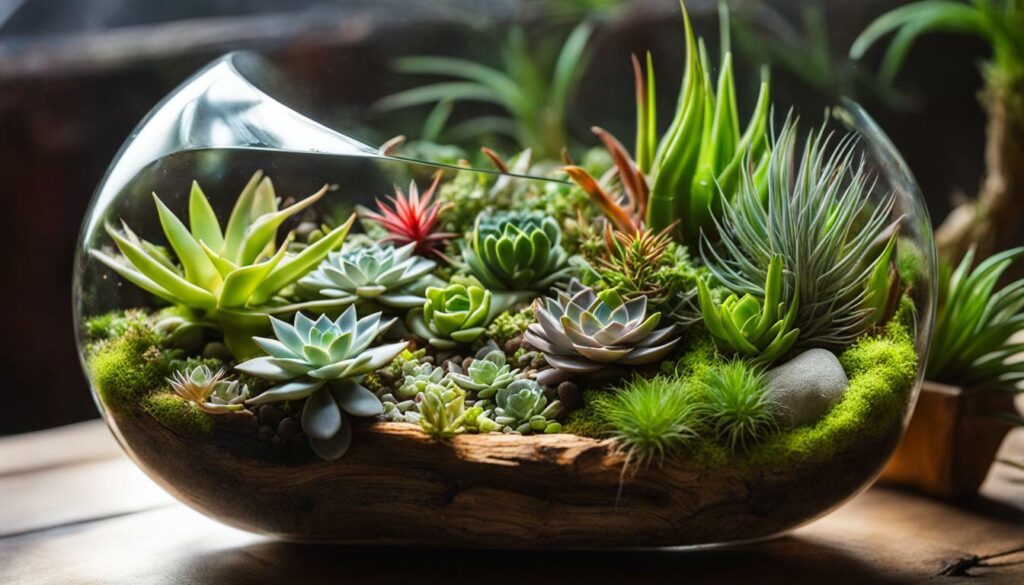
Incorporating small and miniature plants into your closed terrarium not only adds visual appeal but also ensures the longevity of your terrarium. These plants are low maintenance and require little attention once established. Investing in the right plants will save you time and effort in the long run.
Now that you have a better understanding of the small and miniature plants suitable for closed terrariums, you can confidently embark on your terrarium journey. Enjoy the process of creating your own mini green oasis and watch as these plants thrive and bring a touch of nature indoors!
Easy-to-Care-for Terrarium Plants for Beginners
6. If you’re new to terrarium gardening and looking for easy-to-care-for plants, there are several varieties that are perfect for beginners. These plants require minimal maintenance and can thrive in a terrarium environment, making them ideal choices for those starting out. One such plant is the Nerve Plant (Fittonia), which features beautiful, vibrant leaves that add a pop of color to your terrarium. It prefers low to medium light levels and enjoys high humidity, making it a perfect fit for terrariums.
Another great option for beginners is Selaginella, also known as Spike Moss or Club Moss. This plant has delicate, feathery foliage that creates a lush and tropical look in your terrarium. Selaginella thrives in bright, indirect light and prefers high humidity, so it’s important to mist the plant regularly. It’s also a slow-growing plant, which means it won’t outgrow your terrarium too quickly.
For a visual representation of these easy-to-care-for terrarium plants, take a look at the image below:
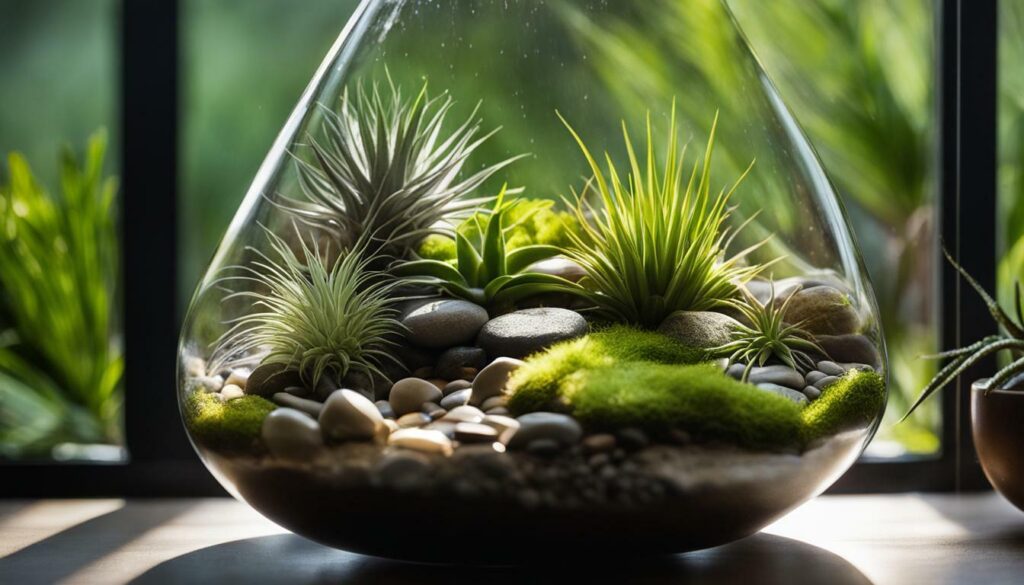
Recommendations for Successful Growth
- Place your terrarium in an area with indirect sunlight, as direct sunlight can cause the temperature inside the terrarium to rise too high.
- Mist the plants regularly to maintain a humid environment, especially for the Nerve Plant and Selaginella.
- Avoid overwatering by allowing the soil or substrate to dry out between waterings.
- Monitor the temperature inside the terrarium to ensure it remains within the optimal range for the selected plants.
- Consider adding a layer of activated charcoal beneath the soil or substrate to help absorb any excess moisture and prevent odor.
Incorporating these easy-to-care-for terrarium plants into your collection is a great way to start your journey into terrarium gardening. Not only are they visually appealing, but they also require minimal maintenance, making them perfect for beginners. Remember to provide the necessary light, humidity, and water to ensure the health and longevity of your terrarium plants.
Creating an Air Plant Terrarium
7. If you’re looking to add a touch of nature to your space, creating an air plant terrarium is a great option. Air plants, also known as Tillandsia, are unique plants that don’t require soil to grow. They can thrive in a terrarium environment, adding a stunning visual appeal to any room. To create your own air plant terrarium, follow these simple steps:
- Choose the right container: Select a glass or clear plastic container that is large enough to accommodate your air plants. Remember, air plants need good air circulation, so choose a container with ventilation holes or an open top.
- Add a suitable substrate: Air plants don’t require soil, but they do need a stable base to anchor themselves. Fill the bottom of your terrarium with decorative rocks, sand, or a special air plant substrate specifically designed for their needs.
- Arrange your air plants: Place your air plants in the terrarium, arranging them in a visually appealing way. You can attach them to decorative objects, such as driftwood or stones, using clear fishing line or non-toxic glue.
- Provide proper lighting: Air plants thrive in bright, indirect light. Place your terrarium near a window or any area with good natural light. Avoid direct sunlight, as it can damage the plants.
- Mist or soak your air plants: Air plants require regular watering to stay hydrated. You can mist them with water using a spray bottle or soak them in water for about 20 minutes once a week. After watering, make sure to let the plants dry completely to prevent rot.
- Decorate your terrarium: Add decorative elements like colorful pebbles, seashells, or miniature figurines to enhance the visual appeal of your air plant terrarium. Get creative and personalize it to match your style and preferences.
You’ve now created your very own air plant terrarium! Remember to care for your air plants by providing them with proper lighting, watering, and occasional fertilization. With the right care, your air plant terrarium will flourish and become a beautiful centerpiece in your home or office.
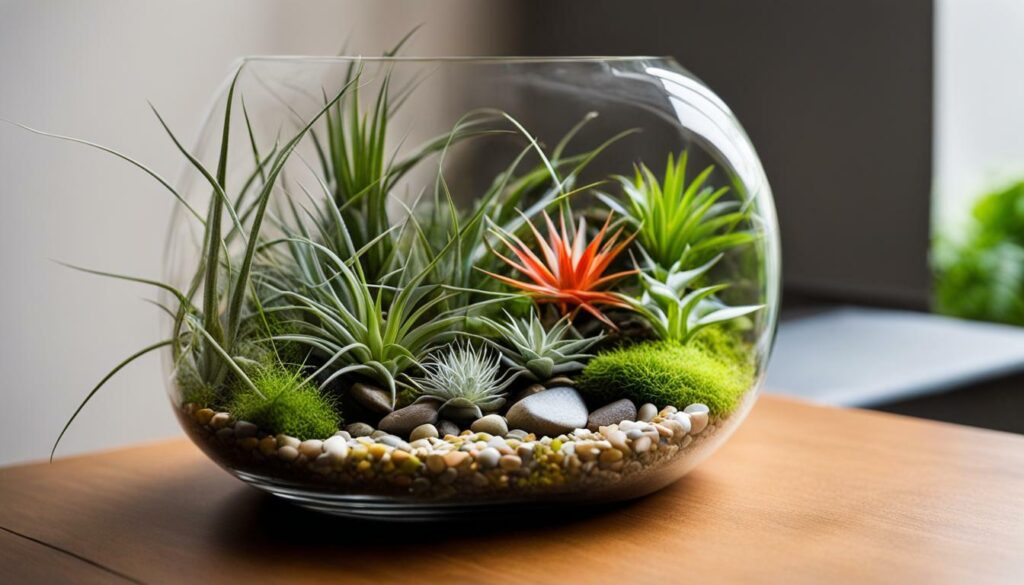
| Air Plant Variety | Light Requirements | Watering Frequency | Growth Size |
|---|---|---|---|
| Tillandsia ionantha | Indirect bright light | 2-3 times a week | Small |
| Tillandsia stricta | Bright, indirect light | Once a week | Medium |
| Tillandsia caput-medusae | Bright, indirect light | 1-2 times a week | Medium |
| Tillandsia xerographica | Bright, indirect light | Once a week | Large |
Table 1 showcases some popular air plant varieties that are well-suited for terrariums. Each variety has its own light requirements, watering frequency, and growth size, allowing you to choose the perfect air plants for your terrarium.
Watering and Caring for Air Plants
8. When it comes to caring for air plants in a terrarium, proper watering is crucial. These unique plants don’t require soil and obtain nutrients and water through their leaves. To ensure their health and longevity, it’s important to understand the right watering techniques.
Air plants in terrariums thrive in environments with high humidity. While misting is a popular watering method, it’s essential to avoid overdoing it, as excessive moisture can lead to rot. Instead, aim to mist your air plants 1-2 times a week, ensuring that the leaves are lightly coated with water. Another effective watering method is soaking, which involves submerging the plants in room temperature water for about 10-15 minutes. After soaking, gently shake off any excess water and allow the plants to dry completely before placing them back in the terrarium.
To maintain a healthy moisture balance, it’s important to consider factors such as the level of humidity in your home or office, the size of your terrarium, and the types of air plants you have. Monitoring the condition of your plants and their surrounding environment is key to determining the frequency and duration of watering.
Fertilizing Air Plants in a Terrarium
Proper fertilization is another crucial aspect of caring for air plants in a terrarium. While these plants can absorb nutrients from the air and surrounding environment, supplementing their diet with a suitable fertilizer can promote growth and overall health.
When selecting a fertilizer, opt for a water-soluble, low-concentration formula specifically made for air plants. Dilute the fertilizer according to the manufacturer’s instructions, as applying a concentrated solution can damage the plants. It’s generally recommended to fertilize air plants once a month during the growing season, which typically occurs in spring and summer.
During the fertilization process, ensure that the entire plant is thoroughly coated with the diluted fertilizer solution. You can achieve this by submerging the plants in the solution for a few seconds or misting them with the diluted mixture. Afterward, allow the plants to dry completely before returning them to the terrarium.
By following the proper watering and fertilization techniques, you can ensure that your air plants thrive and remain healthy within their terrarium environment. Remember to monitor your plants regularly, adapt your care routine based on their needs, and enjoy the beauty and uniqueness that air plants bring to your space.
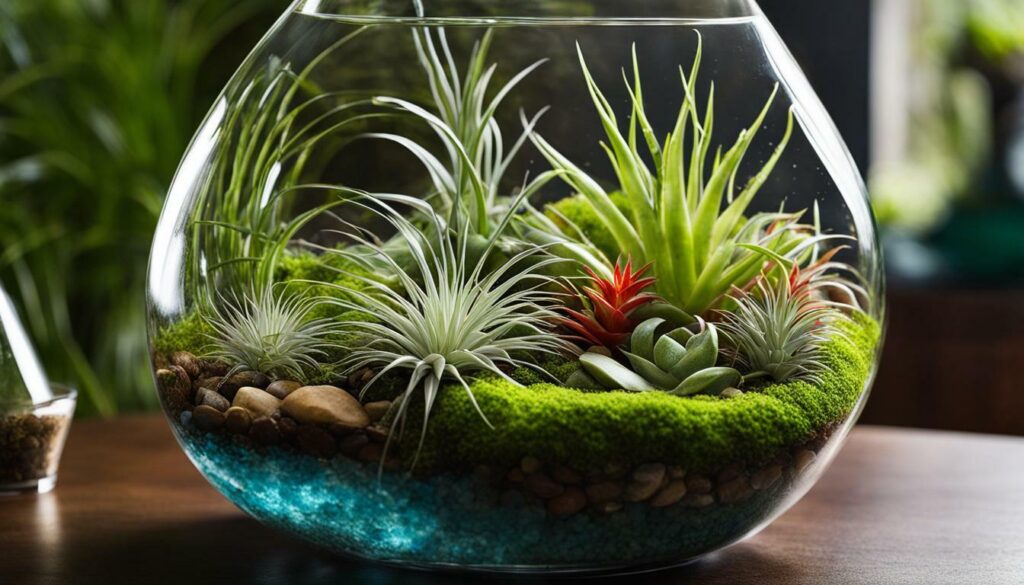
9. Caring for air plants in a terrarium is a rewarding experience, but like any plants, they can encounter problems along the way. Understanding and addressing these common issues promptly can help ensure the health and longevity of your air plants. Here are some of the most common air plant problems and their solutions.
Possible Problem 1: Overwatering
| Possible Causes | Solutions |
|---|---|
| Excessive misting or soaking | Allow plants to dry out completely before watering again |
| Poor drainage in the terrarium | Ensure proper drainage by using a well-draining substrate |
Possible Problem 2: Under-watering
| Possible Causes | Solutions |
|---|---|
| Inadequate misting or soaking | Increase the frequency of watering, especially in drier environments |
| Insufficient humidity in the terrarium | Place a humidity tray or mist the terrarium more frequently |
Possible Problem 3: Pest Infestations
| Possible Pests | Solutions |
|---|---|
| Mealybugs or spider mites | Remove pests manually or use an organic insecticidal soap |
| Fungus gnats | Allow the terrarium to dry out slightly and use yellow sticky traps |
Remember to regularly inspect your air plants for any signs of problems, such as discoloration, wilting, or pests. By promptly addressing these issues with appropriate solutions, you can keep your air plants healthy and thriving in their terrarium environment.
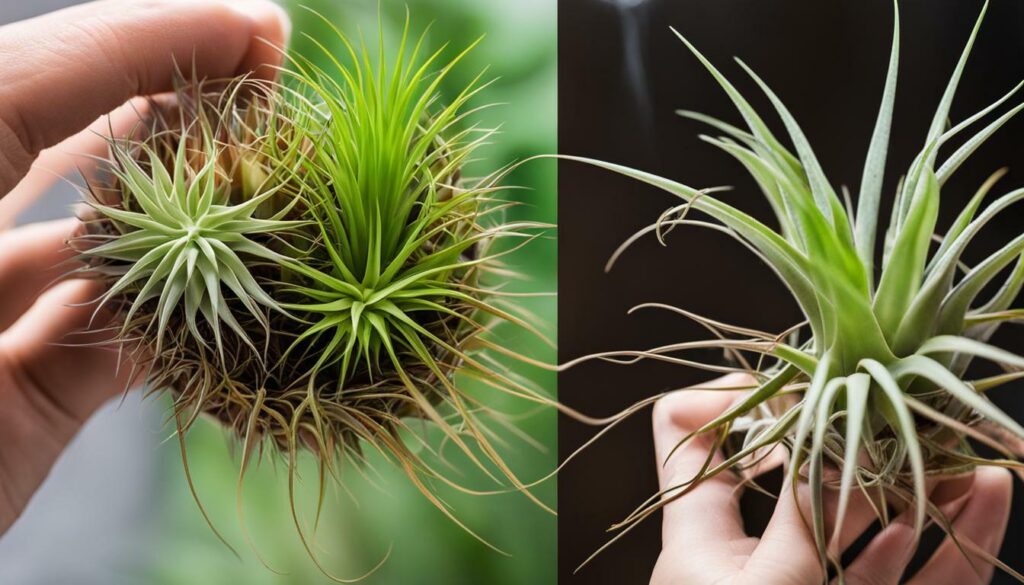
Proper fertilization is key to keeping air plants healthy and thriving in a terrarium environment. While air plants can absorb nutrients from the air and water, supplementing their diet with a balanced fertilizer can promote optimal growth and overall plant health. Here are some tips for fertilizing air plants in a terrarium:
- Choose a suitable fertilizer: Look for a water-soluble fertilizer specifically formulated for air plants or epiphytes. These fertilizers are typically low in nitrogen and high in phosphorus and potassium, providing the essential nutrients that air plants need.
- Follow the recommended dilution: Be sure to dilute the fertilizer according to the manufacturer’s instructions. Over-fertilizing can lead to nutrient burn and damage the delicate roots of air plants. Diluting the fertilizer will help prevent this and ensure that the plants receive just the right amount of nutrients.
- Apply the fertilizer: Mist the air plants with the diluted fertilizer solution, making sure to thoroughly coat the leaves and roots. Alternatively, you can soak the plants in the solution for about 15 minutes once a month. This will allow the plants to absorb the nutrients directly through their leaves and roots.
It’s important to note that air plants in terrariums have different fertilizer requirements compared to those in a more open environment. Terrariums tend to trap moisture, so it’s crucial to avoid over-fertilizing, as this can lead to salt buildup and damage the plants. Regularly monitor the condition of your air plants and adjust the fertilization schedule as needed.
Remember, proper care and maintenance are essential for the health and longevity of air plants in a terrarium. Fertilizing them with a suitable fertilizer will provide the nutrients they need to thrive and add beauty to your terrarium display.
Fertilizing Schedule for Air Plants in a Terrarium
| Month | Fertilizing Frequency |
|---|---|
| January | Every 4 weeks |
| February | Every 4 weeks |
| March | Every 4 weeks |
| April | Every 3 weeks |
| May | Every 3 weeks |
| June | Every 3 weeks |
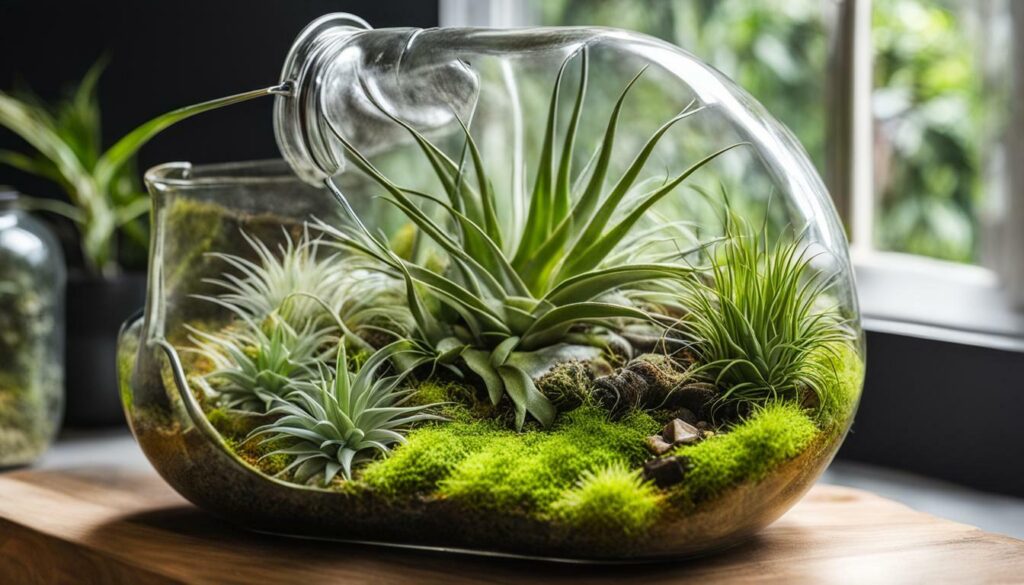
July – Every 3 weeks
August – Every 2 weeks
September – Every 2 weeks
October – Every 2 weeks
November – Every 4 weeks
December – Every 4 weeks
Conclusion
In conclusion, this guide has provided valuable information on choosing and caring for terrarium plants and air plants. Whether you prefer closed or open terrariums, there are specific plants that thrive in each type. It is important to select plants that are suitable for the terrarium environment and complement the overall style and decor.
For those looking to purchase terrarium plants online, there are reputable websites and online marketplaces that offer a wide variety of options. Beginners can also consider starting with small and miniature plants that won’t outgrow the terrarium space, ensuring long-lasting enjoyment.
If you are new to terrarium gardening, easy-to-care-for plants like the Nerve Plant and Selaginella are highly recommended. These plants require minimal maintenance and can adapt well to terrarium conditions.
To create your own air plant terrarium, be sure to follow the step-by-step instructions provided in this guide. Proper arrangement and secure placement of air plants, as well as adequate air circulation and light, are essential for their well-being.
Finally, it is crucial to pay attention to the watering and care requirements of air plants in a terrarium. Mist and soak methods are recommended, as well as considerations for light exposure, temperature, and fertilization. By addressing common air plant problems and providing the necessary nutrients, you can ensure that your terrarium plants and air plants thrive and flourish.
– Are Tillandsia Air Plants Essential for Thriving Terrarium Plants?
Tillandsia air plants are indeed essential for thriving terrarium plants. Their unique ability to absorb nutrients and moisture from the air makes them valuable additions to any terrarium. These low-maintenance terrarium plant essentials come in various shapes and sizes, adding both aesthetic appeal and practical benefits to the enclosed ecosystem.
FAQ
What are terrarium plants?
Terrarium plants are plants that are suitable for growing in enclosed containers, such as glass terrariums. These plants are typically small, low-maintenance, and able to thrive in the humid and controlled environment of a terrarium.
What are air plants?
Air plants, also known as Tillandsia, are a type of plant that do not require soil to grow. They absorb nutrients and moisture through their leaves and can be mounted or placed in various creative ways, making them a popular choice for terrariums.
What are the different types of terrariums?
There are two main types of terrariums: closed and open. Closed terrariums have a sealed environment that forms its own mini-ecosystem, while open terrariums have an open top and allow for more airflow and less humidity.
Which plants are best for closed terrariums?
Plants that thrive in closed terrariums are often those that require high humidity levels and can tolerate lower light conditions. Some suitable plants include ferns, mosses, fittonias, and peperomias.
Which plants are best for open terrariums?
Open terrariums allow for more air circulation and lower humidity levels. Plants such as succulents, cacti, and air plants are well-suited for these types of terrariums.
Where can I find terrarium plants for sale online?
There are various reputable websites and online marketplaces where you can find a wide selection of terrarium plants. Some popular options include Etsy, Amazon, and specialized terrarium plant nurseries.
What are some small and miniature plants suitable for closed terrariums?
Small and miniature plants like baby tears (Soleirolia soleirolii), miniature ferns, and dwarf varieties of fittonia and peperomia are ideal for closed terrariums due to their compact growth habits.
What are some easy-to-care-for terrarium plants for beginners?
The Nerve Plant (Fittonia) and Selaginella are both popular choices for beginners as they are relatively low maintenance and adapt well to the conditions inside a terrarium.
How do I create an air plant terrarium?
To create an air plant terrarium, you will need a suitable container, such as a glass vase or bowl, as well as substrate or decorative elements to anchor the air plants. Follow the instructions provided in the guide for step-by-step directions on setting up an air plant terrarium.
How do I water and care for air plants in a terrarium?
Air plants require regular misting or soaking to ensure they receive the moisture they need. The specific watering routine will depend on factors such as humidity levels and ambient temperature. Refer to the guide for detailed instructions on watering and caring for air plants in a terrarium.
What are some common problems with air plants in a terrarium and how can I solve them?
Common problems with air plants in a terrarium include over-watering, under-watering, pest infestations, and diseases. The guide provides troubleshooting tips and solutions to help address these issues and keep your air plants healthy.
How do I fertilize air plants in a terrarium?
Fertilizing air plants in a terrarium can help provide essential nutrients for their growth and overall health. The guide discusses different fertilization methods, including organic options, and provides guidelines for frequency and application.

